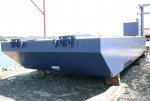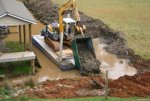Not sure if this is the correct form for the following question, I did post it on one other site and have had some good feed back looking for any thoughts here. I attached a few photos if that helps. Thanks, Mark
We have a 30? x 12? x 3.5? steel barge all .25? plate which weighs approximately 17,000 lbs. It is used for dredging around our dock area; when working it has a 20,000 lb excavator on deck along with a 5 yard container for spoils. The total weight is approximately 45,000 lbs loaded. It is currently powered by a single 150 hp outboard engine which even at half throttle supplies plenty of power for our use. We would like to replace the engine with either hydraulic drives or submersible electric drives because the outboard cooling system has trouble operating in the silt filled shallow water.
Hydraulic Marine Systems, Inc., Harbormaster, and Thrustmaster all make really nice commercial systems but they are all out of my price range.
Our primary use would be for movement in and around the dock and boat house. Most travel would be limited to about two hundred feet from the shore and is on a lake so current is not a concern. This is all personal use and limited to about 80 hours a year.
We are exploring one of two systems:
1: Using twin electric submersible motors (similar to trolling motors but much larger) powered by battery packs.
2: Using single or twin electric motor(s) mounted inside the barge with a hydraulic pump mounted directly to it (them) which would drive the two hydraulic motors mounted in an outboard configuration. This would also be powered by battery packs.
The weight of the batteries is not a major concern; we would probably use AGM batteries because they would be below deck. The batteries would be kept on maintenance charge while not in use from shore power while tied to the dock. Considerable thought was given to using a small diesel to power the hydraulic pump but with the limited use we are leaning to battery power.
Obviously with a barge speed is not a concern even empty it would only travel about 5 MPH, we are only looking for pushing power. We think a pair of 18 to 20 inch diameter propellers with a shallow pitch; slow turning would give us the thrust required.
Considering we only use the current outboard at half throttle or less (it starts to cavitate above ? throttle, most likely because of the small diameter high pitch prop) and still have more than enough performance; it would seem we could design the system for a total of around 30 to 40 HP and still have good results.
Thank you again for reading, any thoughts or suggestions would be welcomed.
Mark
We have a 30? x 12? x 3.5? steel barge all .25? plate which weighs approximately 17,000 lbs. It is used for dredging around our dock area; when working it has a 20,000 lb excavator on deck along with a 5 yard container for spoils. The total weight is approximately 45,000 lbs loaded. It is currently powered by a single 150 hp outboard engine which even at half throttle supplies plenty of power for our use. We would like to replace the engine with either hydraulic drives or submersible electric drives because the outboard cooling system has trouble operating in the silt filled shallow water.
Hydraulic Marine Systems, Inc., Harbormaster, and Thrustmaster all make really nice commercial systems but they are all out of my price range.
Our primary use would be for movement in and around the dock and boat house. Most travel would be limited to about two hundred feet from the shore and is on a lake so current is not a concern. This is all personal use and limited to about 80 hours a year.
We are exploring one of two systems:
1: Using twin electric submersible motors (similar to trolling motors but much larger) powered by battery packs.
2: Using single or twin electric motor(s) mounted inside the barge with a hydraulic pump mounted directly to it (them) which would drive the two hydraulic motors mounted in an outboard configuration. This would also be powered by battery packs.
The weight of the batteries is not a major concern; we would probably use AGM batteries because they would be below deck. The batteries would be kept on maintenance charge while not in use from shore power while tied to the dock. Considerable thought was given to using a small diesel to power the hydraulic pump but with the limited use we are leaning to battery power.
Obviously with a barge speed is not a concern even empty it would only travel about 5 MPH, we are only looking for pushing power. We think a pair of 18 to 20 inch diameter propellers with a shallow pitch; slow turning would give us the thrust required.
Considering we only use the current outboard at half throttle or less (it starts to cavitate above ? throttle, most likely because of the small diameter high pitch prop) and still have more than enough performance; it would seem we could design the system for a total of around 30 to 40 HP and still have good results.
Thank you again for reading, any thoughts or suggestions would be welcomed.
Mark






















